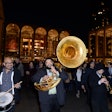
John Marenzana, Lighthouse International
Photo: Dorothea Anne Lombardo
How can hosts make sure a space is accessible for visually impaired guests?
Planners should ask themselves, “If I were wearing a blindfold, what would be helpful to me?” Consider how the layout of the room will affect guests who have guide dogs or canes. If you’re in a large space with hard floors, put runners on the ground to create walkways. Guests will be able to feel the textural difference under their feet or with a cane, which will help guide them around the room. They should also check for Braille signage on bathroom doors and elevator buttons and make sure the venue’s entryway is easily accessible. We are developing an audit sheet for event planners with all of these details so they can use it as a checklist to make the process easier.
Have you noticed that this is a growing concern?
Definitely. Being visually impaired doesn’t necessarily mean someone is blind. With the expansion of baby boomers, there’s an even greater number of people with visual impairments like macular degeneration.Is there anything special that staffers should do when escorting someone?
There’s a misconception that you should lead a visually impaired person by the arm. Instead, you should offer them your elbow and let them hold on to you. When you take a person by the arm, you’re pulling them and they don’t know where they’re going. This is safer and gives them more control.
How should staff greet and welcome a visually impaired person?
In many cases, you’ll find that reception staff freeze up and don’t know what to do when they encounter a visually impaired guest. They need to know who you are, so when you say hello, use your name to establish a better rapport.
What are some ways to make visual presentations more inclusive?
Consider the size and color of text on screens. Use highly contrasting colors and fonts that are 16 to 18 points for handouts and a minimum of 24 points for projections. If you’re showing a video, visually impaired guests can use earphones to listen to a descriptive narrative that describes what’s happening on-screen. We can provide referrals for companies that specialize in this service. Having handouts in a larger font or in Braille is also a good idea.
How do you assist visually impaired guests during a meal in an unobtrusive way?
If you’re having a buffet, you could have Braille labels in front of dishes or position staffers behind tables to describe what’s being served and offer assistance. For plated meals, waitstaff should be briefed on how to present the meal in a way that will help guests “see” what’s in front of them. Without making a big production, waitstaff can point out what’s on a guest’s plate by saying, “At 12:00, you have your vegetable; at 9:00, you’ve got your protein.” With a little sensitivity and awareness, it will make your event much smoother.
Planners should ask themselves, “If I were wearing a blindfold, what would be helpful to me?” Consider how the layout of the room will affect guests who have guide dogs or canes. If you’re in a large space with hard floors, put runners on the ground to create walkways. Guests will be able to feel the textural difference under their feet or with a cane, which will help guide them around the room. They should also check for Braille signage on bathroom doors and elevator buttons and make sure the venue’s entryway is easily accessible. We are developing an audit sheet for event planners with all of these details so they can use it as a checklist to make the process easier.
Have you noticed that this is a growing concern?
Definitely. Being visually impaired doesn’t necessarily mean someone is blind. With the expansion of baby boomers, there’s an even greater number of people with visual impairments like macular degeneration.Is there anything special that staffers should do when escorting someone?
There’s a misconception that you should lead a visually impaired person by the arm. Instead, you should offer them your elbow and let them hold on to you. When you take a person by the arm, you’re pulling them and they don’t know where they’re going. This is safer and gives them more control.
How should staff greet and welcome a visually impaired person?
In many cases, you’ll find that reception staff freeze up and don’t know what to do when they encounter a visually impaired guest. They need to know who you are, so when you say hello, use your name to establish a better rapport.
What are some ways to make visual presentations more inclusive?
Consider the size and color of text on screens. Use highly contrasting colors and fonts that are 16 to 18 points for handouts and a minimum of 24 points for projections. If you’re showing a video, visually impaired guests can use earphones to listen to a descriptive narrative that describes what’s happening on-screen. We can provide referrals for companies that specialize in this service. Having handouts in a larger font or in Braille is also a good idea.
How do you assist visually impaired guests during a meal in an unobtrusive way?
If you’re having a buffet, you could have Braille labels in front of dishes or position staffers behind tables to describe what’s being served and offer assistance. For plated meals, waitstaff should be briefed on how to present the meal in a way that will help guests “see” what’s in front of them. Without making a big production, waitstaff can point out what’s on a guest’s plate by saying, “At 12:00, you have your vegetable; at 9:00, you’ve got your protein.” With a little sensitivity and awareness, it will make your event much smoother.



















